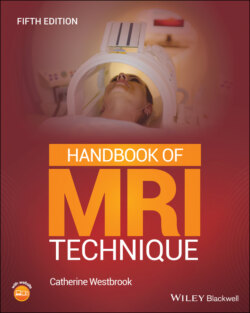Читать книгу Handbook of MRI Technique - Catherine Westbrook - Страница 33
SPATIAL RESOLUTION
ОглавлениеSpatial resolution is the ability to distinguish between two points as separate and distinct. It is controlled by the voxel size. Spatial resolution may be increased by selecting:
thin slices
fine matrices
a small FOV.
These criteria assume a fixed, square FOV so that if an uneven matrix is used, the pixels are rectangular and therefore spatial resolution is lost. Alternatively, square pixels can be maintained so that the phase matrix determines the size of the FOV along the phase encoding axis (phase FOV). Spatial resolution is maintained because the pixels are always square. However, the size of the FOV may be inadequate to cover the required anatomy in the phase direction of the image and any attempt to increase it increases scan time. In addition, SNR is often reduced due to the use of smaller, square pixels. In the interests of simplicity, a square FOV is assumed in Part 2, whereby the phase matrix determines spatial resolution, not the size of the phase FOV.
In Part 2, the following terms and approximate resolution parameters are suggested. The first number quoted is the frequency matrix; the second is the phase matrix (see also Table 2.1):
A coarse matrix is 256×128 or 256×192.
A medium matrix is 256×256 or 512×256.
A fine matrix is 512×512.
A very fine matrix is any matrix 1024×1024 or higher.
A small FOV is less than 16 cm or 160 mm.
A large FOV is more than 30 cm or 300 mm.
A thin slice/gap is 1 mm/1 mm (or thinner) to 3 mm/1 mm.
A medium slice/gap is 4 mm/2 mm to 6 mm/2.5 mm.
A large slice/gap is 7 mm/3 mm or thicker.
